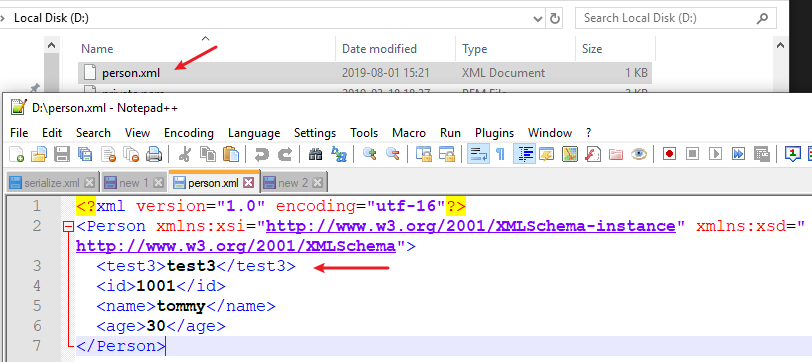序列化是将对象保存为文本文件或二进制文件;
反序列化则是读取文件信息,还原为对象;
序列化保存为文本内容,主要是 xml 和 json 两种,这里介绍序列化为 xml 文件的方式。
想要序列化,先要在类上添加 [Serializable] 特性标签,如:
[Serializable] public class Person { private string test1 = "test1"; protected string test2 = "test2"; public string test3 = "test3"; internal string test4 = "test4"; public int id { get; set; } public string name { get; set; } public int age { get; set; } public override string ToString() { return $"[id={id}, name={name}, age={age}, test1={test1}, test2={test2}, test4={test3}, test4={test4}]"; } }
C# 中处理 xml 序列化的相关类都在 System.Xml.Serialization 命名空间下,这里通过使用 XmlSerializer 类来实现序列化和反序列化:
public class xml_serializer_manager{ /// <summary> /// serialize object to xml file. /// </summary> /// <param name="path">the path to save the xml file</param> /// <param name="obj">the object you want to serialize</param> public void serialize_to_xml(string path, object obj) { XmlSerializer serializer = new XmlSerializer(obj.GetType()); string content = string.Empty; //serialize using (StringWriter writer = new StringWriter()) { serializer.Serialize(writer, obj); content = writer.ToString(); } //save to file using (StreamWriter stream_writer = new StreamWriter(path)) { stream_writer.Write(content); } } /// <summary> /// deserialize xml file to object /// </summary> /// <param name="path">the path of the xml file</param> /// <param name="object_type">the object type you want to deserialize</param> public object deserialize_from_xml(string path, Type object_type) { XmlSerializer serializer = new XmlSerializer(object_type); using (StreamReader reader = new StreamReader(path)) { return serializer.Deserialize(reader); } } }
使用方法:
序列化:
xml_serializer_manager manager = new xml_serializer_manager(); string path = @"D:person.xml"; Person p = new Person { id=1001, name="tommy", age=30}; manager.serialize_to_xml(path, p);
结果如下:
生成 person.xml 文件,而且只处理了 public 修饰的属性,其他都不处理

反序列化:
xml_serializer_manager manager = new xml_serializer_manager(); string path = @"D:person.xml"; Person p = (Person)manager.deserialize_from_xml(path, typeof(Person)); Console.Write(p.ToString());
结果:
